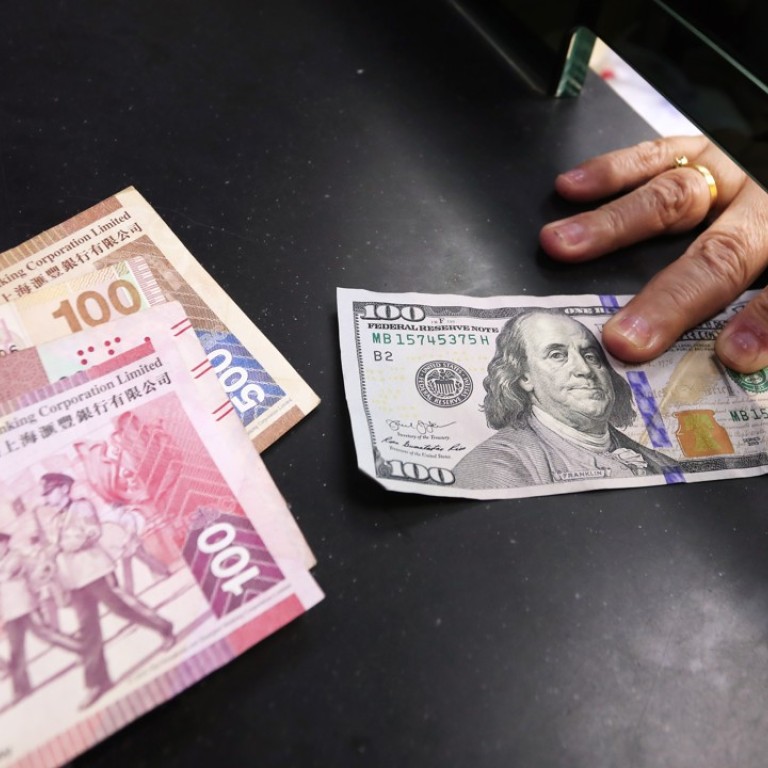
Hong Kong Monetary Authority buys HK$3.26 billion worth of own currency to head off declines
HKMA deputy Howard Lee warns homeowners to ‘be mindful’ of their mortgage repayment obligations as city’s monetary conditions become tighter
Hong Kong’s de facto central bank said on Friday it had bought HK$3.26 billion of its own currency by selling US$415.3 million worth of US dollars in an attempt to prop up the Hong Kong dollar, which had slumped to its weakest level in 35 years and breached the lower limit of its trading band for the first time.
The Hong Kong Monetary Authority stepped in to buy the Hong Kong dollar and sell the American currency in two separate transactions, one during European trading hours yesterday, and the other before the close of trading in New York, according to its deputy chief executive, Howard Lee.
The move marks the latest step in tightening Hong Kong’s monetary conditions, sparking concerns among homeowners about possible interest rate increases that will increase their mortgage repayments.
The Hong Kong dollar’s peg to the US dollar means the HKMA does not have an independent monetary policy, and cannot do more than compel local interest rates to track US interest rates rather than the city’s economic conditions.
Global growth recovery in recent years has prompted the HKMA’s intervention. It is attempting to engineer a gradual increase in interest rates even as other Asian central banks tighten monetary policy in the footsteps of the US Federal Reserve, as global growth recovers. Singapore’s central bank tightened monetary policy for the first time in six years on Friday, increasing the slope of the Singapore dollar’s policy band. Malaysia’s central bank tightened policy in January, and the Bank of Korea raised interest rates in November.
At an HKMA press conference on Friday morning, Lee said that while property prices were determined by a combination of factors, and not just mortgage and interest rates, debtors should be mindful of their repayment capabilities.
The de facto central bank’s intervention came after the Hong Kong dollar slipped to 7.8500 against the greenback yesterday, a level that compels the HKMA to take action in the market.
The transactions, conducted at the 7.8500 rate, are in line with Hong Kong’s “linked exchange-rate system” and were aimed at “normalising monetary conditions” so the city’s interest rates would move closer to those in the US, Lee said.
The move meant Hong Kong’s aggregate balance, the level of liquidity in the banking system, would fall to HK$176.5 billion from HK$180 billion as of the settlement date on April 16, according to Lee.
The HK$180 billion level is very high and the “normalisation process” will be gradual with incremental interest rate increases, he added.
Interest rates would rise more rapidly if the aggregate balance were cut to a level of HK$50 billion to HK$100 billion, analysts said.
Frances Cheung, head of macro strategy in Asia at Westpac, said interest rates would also rise sharply if demand for US dollar assets was combined with a market risk-off sentiment, which would trigger capital outflows.
In response to the HKMA’s foreign exchange operations, the Hong Kong interbank offered rate – a gauge of banks’ borrowing costs – rose across the board on Friday. The one month Hibor jumped by 6 basis points to 0.85 per cent, its biggest daily rise in two weeks. The three month Hibor climbed by 4 basis points to 1.21 per cent, its biggest increase in more than four months.
The city’s dollar was pegged at 7.8 to the greenback in October 1983, with a trading band of 7.75 to 7.85 introduced in 2005. Under this mechanism, the HKMA is obliged to intervene in the interbank market to prevent the currency from trading beyond that range.
This week’s Hong Kong dollar purchases marks the HKMA’s first intervention in the interbank market to defend the weak side of the peg since 2005. In 2005, it bought HK$3.26 billion of the local currency amid expectations of a stronger Chinese yuan.
In 2015, the HKMA had to step in to the foreign exchange market when the Hong Kong dollar hit the strong end as investors switched out of a devalued yuan. The Chinese currency tumbled 4 per cent and touched a 4.5-year low in 2015, and the HKMA had to sell HK$227.15 billion to weaken the Hong Kong dollar.
Lee blamed the fall in the Hong Kong dollar to its weak side of the band on widening Hong Kong and US interest rate differentials.
The Hong Kong dollar started to reverse from its appreciation trend in the past year as excessively flushed liquidity caused by funds flowing into the city’s property and stocks was causing the Hong Kong rate discount with its US counterpart to widen sharply as the US began tightening monetary policy.
Foreign exchange traders have been actively selling Hong Kong dollars and buying the US currency in an arbitrage called the carry trade, which sells a low-yielding asset to buy another with higher returns, as they take advantage of the price difference between their borrowing costs, and thereby exerting depreciation pressure on the local currency.
The Hong Kong dollar has been one of the biggest losers among a dozen Asian currencies in the past year, declining by about 14 per cent against the euro and 7 per cent against the yuan.
The city’s currency breached the critical level in the early hours of the morning and several times again in the late afternoon before pulling back. The HKMA stepped in twice, buying HK$811 million of the local currency on the first occasion, and HK$2.44 billion on the second.
The Hong Kong dollar was changing hands at 7.8499 as of 6pm on Friday, where it is expected to hover around in the coming months.

